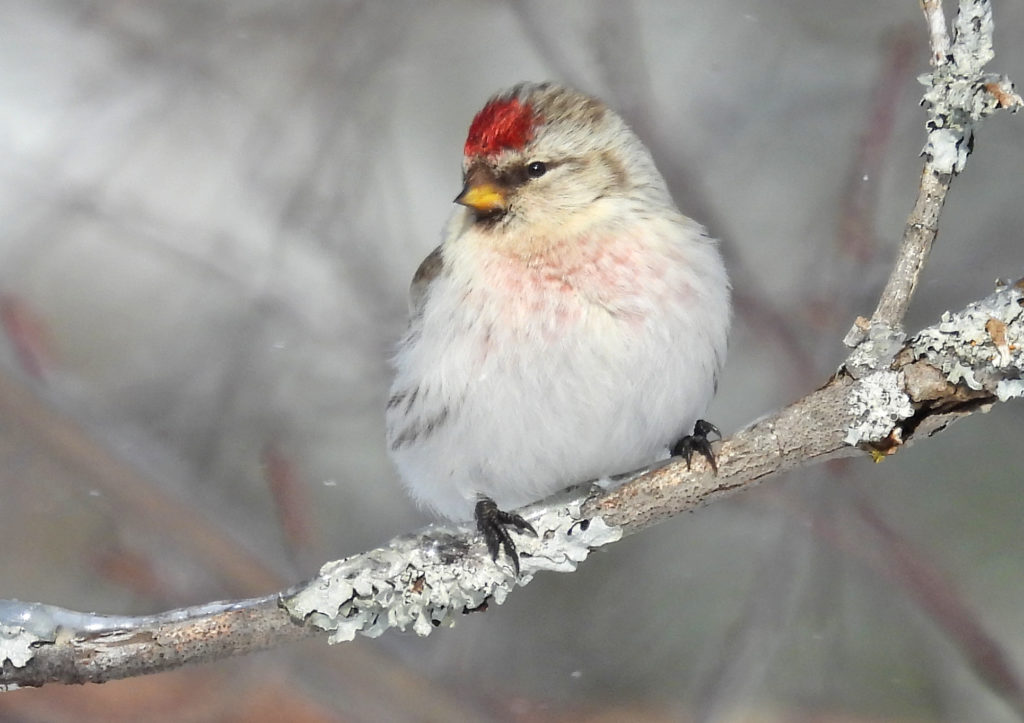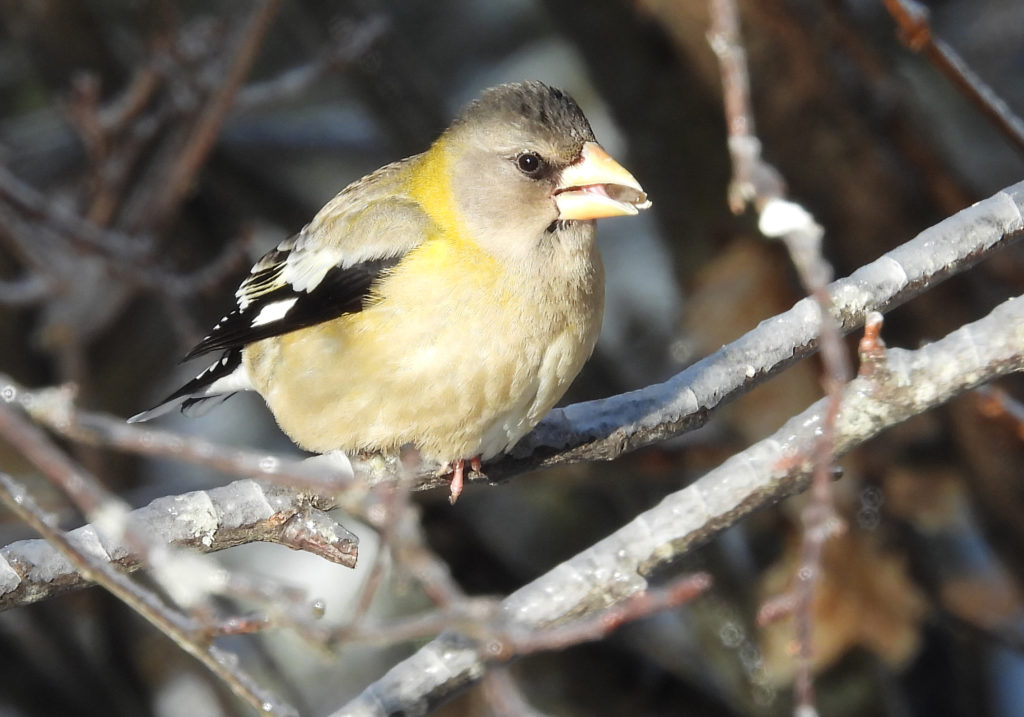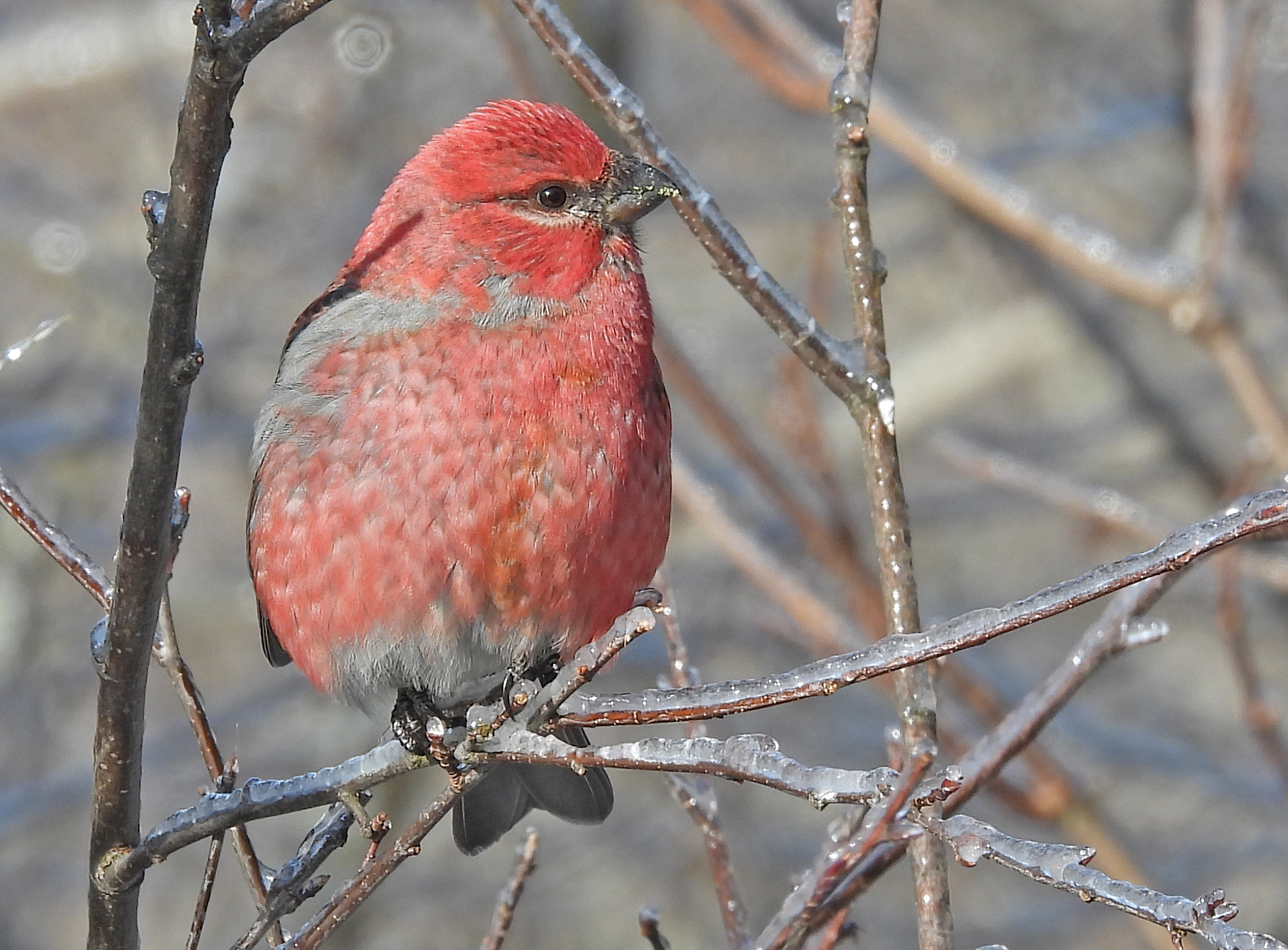Post Photo: ©Jean Iron
GENERAL FORECAST 2022-23.
In eastern North America, westward to northwestern Ontario and upper midwestern states, there should be a flight year for several species. See individual species forecasts.
In eastern North America, there is a good food crop along the coastal areas of Maritime Provinces southward into New England, which should hold many finches this winter. Inland from this area to areas west of Lake Superior, the cone and berry crops are generally poor, with scattered pockets of good crops.
There is a significant masting event involving spruce crops from interior northern British Columbia/Northwest Territories spreading eastward to far northwestern Ontario, providing a bumper crop of seeds. One cone crop reporter stated it was the heaviest crop they have ever seen, with branches looking to break under the weight! This bumper crop also spreads southward along the Rocky Mountains and provides a good cone crop southward into northern Arizona. Large numbers of crossbills and siskins will move into this masting event this fall and winter.
INDIVIDUAL FORECASTS
Forecasts apply mainly to Ontario and adjacent provinces and states. Three irruptive non‐finch passerines whose movements are often linked to finches are also discussed. Follow finch wanderings this fall and winter on eBird, the Finch Research Network, and the Finches, Irruptions and Mast Crops FaceBook group for more information.
PINE GROSBEAK
From western Lake Superior eastward,the native mountain-ash berry crops are poor to below average, with areas of above-average crops along the Atlantic coast. From Lake Superior westward, the crop is above average, with several areas of bumper crops.
Traditional areas in the upper Midwest states eastward to New England and the Maritime Provinces should see movements of Pine Grosbeaks. Flocks of hungry grosbeaks searching for fruiting ornamental trees and well-stocked feeders with black oil sunflower seeds may be seen in urban areas.
PURPLE FINCH
Many Purple Finches will migrate south from Eastern Canada this winter. Early movement of this species southward has been occurring for weeks. With several large Spruce Budworm outbreaks in the eastern boreal forest, the Purple Finches appear to benefit from an abundant food source during the breeding season. The ash crop is good in many areas of the northeast where ash is dying from emerald ash borer, so some birds could linger, but look for them to be most common south of the eastern boreal and northern tier states.

COMMON AND HOARY REDPOLLS
There appears to be no bumper birch crop in North America this winter. In the western boreal forest, it appears to be mostly an average birch crop. East of Manitoba, the White and Yellow Birch crop is very poor to poor throughout most of the boreal and southern Canadian forests. The Alder crop across the boreal forest is average. There is a potential for a moderate to a good flight south out of the boreal forest. Watch for redpolls on birches, in weedy fields and at bird feeders offering nyger and black oil sunflower seeds. Watch for Hoaries in flocks of Common Redpolls. See the link below for photos and identification marks of the Common and Hoary Redpoll subspecies.
PINE SISKIN
A large number of Pine Siskins will remain in the bumper spruce crop of western Canada this winter. In the eastern boreal forest, there are extensive pockets of heavy Eastern White Cedar crops which should hold small numbers of siskins this winter. However, most of the siskins remaining in the east this fall should move southward in search of food. At feeders, they prefer nyger seeds in silo feeders.
WHITE-WINGED CROSSBILL
The crossbill pendulum has swung west for this winter. A bumper White Spruce crop and heavy crops of other conifers in the boreal forest from northwestern Ontario to northern British Columbia and southward through the Rocky Mountains should contain most of the White-winged Crossbills this winter. Throughout the boreal forest from Lake Superior, eastward spruce crops are mostly poor, with areas of patchy fair crops and widespread poor Tamarack crops. Later in winter, crossbills might start wandering some as crops are depleted, and any cones, even old cones, should be watched for crossbills and siskins.
RED CROSSBILL
Red Crossbills are currently quite common in eastern Massachusetts, along the coast of Maine and the southern Maritime Provinces. There are modest numbers in the Adirondacks, Algonquin Provincial Park, over to the upper Great Lakes. These areas are where the “eastern Type 10” is most common from year to year, and this year is no different, with the heavy red spruce crop along the coast and localized heavy eastern white pine crop driving the majority of the current distribution. In short, this “Northeastern Crossbill” (i.e. eastern Type 10) will be around this winter, but will they migrate down the coast to Long Island, Cape May and Delaware and points south, as they sometimes do as cone crops are depleted as we progress through the winter season. Type 2 has been on the move a little this summer, so we may get some Type 2 and 3 once the western crops are depleted. Lastly, expect a sprinkling of Type 1 and 2 in the usual areas of New York and western Massachusetts. The call types are usually impossible to identify without recordings of their flight calls. Recordings can be made with a smartphone and identified to type. Matt Young (may6@cornell.edu or info@finchnetwork.org) will identify types if you email him your recordings or upload them to an eBird checklist. Recordings uploaded to eBird checklists are deposited in the Macaulay Library. See Matt Young’s guide to Red Crossbill call types in the links below.
EVENING GROSBEAK
This stocky charismatic finch appears to be on the move this winter. Its breeding population appears to be increasing in Eastern Canada westward to Manitoba due to increasing outbreaks of spruce budworm with large outbreaks in Northeastern Ontario and Quebec. Visual count observations by Tadoussac Bird Observatory in Quebec show a movement with several individuals making it into Southern Ontario and Pennsylvania by mid-September. Expect flights of Evening Grosbeaks into southern Ontario, southern Quebec, Maritime Provinces, and border states this fall. If this species repeats the large, fast-moving, long-distance flights seen in late October 2020, some birds could be expected to go farther south into the United States than usual. At large platform feeders, they prefer black oil sunflower seeds. Evening Grosbeaks will look for maple and ash trees holding seed away from feeders. See the link below for Evening Grosbeak call types.
THREE IRRUPTIVE PASSERINES
Movements of these three passerines are often linked to the boreal finches.
BLUE JAY
This will be a good to strong flight year. Beechnut and hazelnut crops are poor. The acorn crop is generally poor but with pockets of good crops scattered from Manitoba eastward through southern Canada and northeastern states southward to Pennsylvania.
RED-BREASTED NUTHATCH
This species has been irrupting south since July and continues as this forecast is written. With mostly poor cone crops in the eastern boreal forest, expect this species to continue to move southward. This species prefers black oil seeds, suet, and peanuts at feeders.
BOHEMIAN WAXWING
In the eastern boreal forest, the native mountain-ash berry crops are poor to below average, and other berry crops range from fair to good. Westward from Northwestern Ontario, the crop ranges from good to bumper.
Look for this species in traditional areas from Central Ontario eastward into the maritime provinces, northern New England and Great Lake states. As winter progresses and food resources dwindle, flocks may be seen further south of these traditional areas.
Bohemians coming south to forage will visit reliable annual crops of abundant Buckthorn (Rhamnus) berries and urban areas containing planted European Mountain-ash berries and ornamental crabapples.
FiRN is a nonprofit, and has been granted 501c3 status. FiRN is committed to researching and protecting these birds and other threatened finch species like the Evening Grosbeak, Rosy-finches, and finches of Hawaii (aka the honeycreepers), and if you have been enjoying all the blogs and identifying of Red Crossbill and Evening Grosbeak call types, redpoll subspecies and green morph Pine Siskins FiRN has helped with over the years, please think about supporting our efforts and making a small donation at the donate link below.
Donate – FINCH RESEARCH NETWORK (finchnetwork.org)
Shirt Link
For a commemorative Winter Finch Forecast shirt where proceeds will go towards the study and conservation of finches and their habitats globally, see here: https://finchnetwork.org/shop
The Finch Research Network is also working on a feedercam co-sponsored by Aspen Song wild bird seed to go up sometime later in the season.
Featured Image of Pine Grosbeak credited to Jean Iron
Finch Information Links
- Crossbills of North America: Species and Red Crossbill Call Types. https://ebird.org/news/crossbills-of-north-america-species-and-red-crossbill-call-types/
- A Crossbill’s Guide to Conifers of the Eastern Forest: A How-to for Finding Crossbills – FINCH RESEARCH NETWORK (finchnetwork.org)
- Finch Research Network with finch species information https://finchnetwork.org/
- Evening Grosbeak Call Types https://finchnetwork.org/species/grosbeaks/the-evening-grosbeak-project To support research and conservation for this species of conservation concern: https://finchnetwork.org/donate
- Previous Winter 1999-2019 http://www.jeaniron.ca/WFFindex.htm
- 2020-21 Winter Forecasts are available under the menu at https://finchnetwork.org/
- Subspecies of Common and Hoary Redpolls – ID Tips and Photos.http://www.jeaniron.ca/2015/redpollsRP.htm
I would like to thank the many birders, naturalists, biologists, and foresters whose tree seed reports allowed me to make this forecast:
Charmaine Anderson (Northern ON), Nick Anich (Northwestern WIS), Cathy Antoniazzi (Prince George BC), Juliet Berger (Southeast MI), Sarah Bonnett (Churchill MB), Jack Bowling (Prince George, BC), Ryan Brady (Northwestern WIS), Angus Bruce (Kodiak AK), Peter Burke (Sudbury ON), Mark Calhoun (Central ON), Geoff Carpentier (Southern ON), Caleb Centanni (Oregon), Joan Collins (Adirondacks NY), John Corden (Flin Flon MB), Ian Cook (Northern ON), Ian Cruickshank (Vancouver Island BC), Jason Dain (Nova Scotia), Michael Dawber (Rainy River District ON), Clinton Dexter-Nienhaus (Sax-Zim Bog and Northern MN), Bruce Di Labio (Eastern ON, NB), Jessé Roy-Drainville (Gaspesie, Tadoussac QC), Nancy Dowd (Nova Scotia), Dave Elder (Atikokan ON), Chris Evans (Northern ON), Craig Evans (Northern ON), Michael Ferguson (Northern ON), Harold Fisher (SK, AB), Marcel Gahbauer (Eastern Canada), Bill Gilmour (Presqu’ile Provincial Park ON), David Govatski (NH and VT), Amanda Guercio (Northern AB, NL), Violet and Susan Hall (Eastern Canada), Kevin Hannah (Northern ON), Glenn Hodgkins (Maine), Danica Hogan (Northwest Territories), Tanner Jackson (Northern AB), Susan Kielb (Upper Pennisula MI), Carolina Lambert ( Banff and Canmore AB), Kent Ladell (Southwestern AB), Derek Lovitch (Southern ME), Stuart Mackenzie (Nipissing District ON), Bruce Mactavish (Newfoundland), Colleen Matula (Northern WI), Angela Mcdonald (Nova Scotia), Stacy McNulty (Adirondack NY), Eric and Anne Mills (Nova Scotia), Bruce Murphy (Hilliardton Marsh Research & Education Centre, Timiskaming District ON, Central AB), Bryant Olsen (Utah), Mark Peck (Haliburton ON), Pennsylvania Dept of Conservation and Natural Resources, Bureau of Forestry, Pennsylvania Natural Heritage Program, Justin Peter (Central and Eastern ON), Fred Pinto (Nipissing District ON), Brian Ratcliff (Lake Superior and Northern ON), Janice Sharp ( Northern WI), Bill Sheehan (Northern ME), Donald Sutherland (Peterborough ON), Alexandre Terrigeol (Tadoussac PQ), Larry Therrien (Western MA), Doug Tozer (Eastern Canada), Declan Troy (Alaska), Angie and Ken Williams (Smooth Rock Falls ON), Jason Wilder (Kaibab AZ), Quinten Wiegersma (Algonquin Park ON), Alexandra Windsor (Churchill MB), David Yeany (western PA), and Matt Young (NY, MA).
Thank you to Jean Iron for providing the photos. Thanks to Susan Hall, Matt Young, and Ron Pittaway for reviewing the forecast.

24th Annual Winter Finch Forecast: The first was posted to the Ontbirds and Birdchat listservs in 1999.
Tyler Hoar Oshawa, Ontario. Finch Research Network, September 25, 2022.

